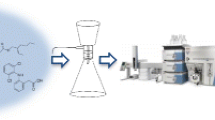Abstract
A reliable quantification by LC-ESI-MS/MS as the most suitable analytical method for polar substances in the aquatic environment is usually hampered by matrix effects from co-eluting compounds, which are unavoidably present in environmental samples. The standard addition method (SAM) is the most appropriate method to compensate matrix effects. However, when performed manually, this method is too labour- and time-intensive for routine analysis. In the present work, a fully automated SAM using a multi-purpose sample manager “Open Architecture UPLC®-MS/MS” (ultra-performance liquid chromatography tandem mass spectrometry) was developed for the sensitive and reliable determination of 29 polar pesticide metabolites in environmental samples. A four-point SAM was conducted parallel to direct-injection UPLC-ESI-MS/MS determination that was followed by a work flow to calculate the analyte concentrations including monitoring of required quality criteria. Several parameters regarding the SAM, chromatography and mass spectrometry conditions were optimised in order to obtain a fast as well as reliable analytical method. The matrix effects were examined by comparison of the SAM with an external calibration method. The accuracy of the SAM was investigated by recovery tests in samples of different catchment areas. The method detection limit was estimated to be between 1 and 10 ng/L for all metabolites by direct injection of a 10-μL sample. The relative standard deviation values were between 2 and 10 % at the end of calibration range (30 ng/L). About 200 samples from different water bodies were examined with this method in the Rhine and Ruhr region of North Rhine-Westphalia (Germany). Approximately 94 % of the analysed samples contained measurable amounts of metabolites. For most metabolites, low concentrations ≤0.10 μg/L were determined. Only for three metabolites were the concentrations in ground water significantly higher (up to 20 μg/L). In none of the examined drinking water samples were the health-related indication values (between 1 and 3 μg/L) for non-relevant metabolites exceeded.





Similar content being viewed by others
References
Wiebke T (2010) Übersicht nicht relevanter Grundwassermetaboliten von Pflanzenschutzmittel-Wirkstoffen. BVL - Bundesamt für Verbraucherschutz und Lebensmittelsicherheit 2010
Pflanzenschutzmittel – Stoffgruppen und Anwendung (2008) Bayerisches Landesamt für Umwelt. http://www.lfu.bayern.de/umweltwissen/doc/uw_51_pflanzenschutzmittel_stoffgruppen_anwendung.pdf
Chicharro M, Bermejo E, Sánchez A, Zapardiel A, Fernandez-Gutierrez A, Arraez D (2005) Multiresidue analysis of phenylurea herbicides in environmental waters by capillary electrophoresis using electrochemical detection. Anal Bioanal Chem 382(2):519–526
Pflanzenschutzmittel in der Umwelt (2008) http://www.lfu.bayern.de/umweltwissen/doc/uw_52_pflanzenschutzmittel_umwelt.pdf
Schmidt CK, Brauch HJ (2008) N,N-dimethylsulfamide as precursor for N-nitrosodimethylamine (NDMA) formation upon ozonation and its fate during drinking water treatment. Environ Sci Technol 42(17):6340–6346
Gesundheitliche Orientierungswerte (GOW) für nicht relevante Metaboliten (nrM) von Wirkstoffen aus Pflanzenbehandlungs- und Schädlingsbekämpfungsmitteln (2009) http://www.umweltdaten.de/wasser/themen/trinkwassertoxikologie/tabelle_gow_nrm.pdf
Gesundheitliche Orientierungswerte (GOW) für nicht relevante Metaboliten (nrM) von Wirkstoffen aus Pflanzenschutzmitteln (PSM) (2008) http://www.umweltdaten.de/wasser/themen/trinkwassertoxikologie/tabelle_gow_nrm.pdf
91/414/EEC D (2003) Guidance Document of the assessment of the relevance of metabolites in groundwater of substances regulated under council derective 91/414/EEC EUROPEAN COMMISSION
Dieter HH (2010) The relevance of “non-relevant metabolites” from plant protection products (PPPs) for drinking water: the German view. Regul Toxicol Pharmacol 56(2):121–125
Grundwasser-Überwachungsprogramm (2009) LUBW Landesanstalt für Umwelt, Messungen und Naturschutz Baden-Württemberg
Kowal S, Balsaa P, Werres F, Schmidt TC (2009) Determination of the polar pesticide degradation product N,N-dimethylsulfamide in aqueous matrices by UPLC-MS/MS. Anal Bioanal Chem 395(6):1787–1794
Kowal S, Balsaa P, Werres F, Schmidt TC (2012) Reduction of matrix effects and improvement of sensitivity during determination of two chloridazon degradation products in aqueous matrices by using UPLC-ESI-MS/MS. Anal Bioanal Chem 403(6):1707–1717
Polar pesticide-metabolites in drinking and mineral water (2008) Chemisches und Veterinäruntersuchungsamt. http://cvuas.untersuchungsämter-bw.de/pdf/EPRW08-watermetabolites.pdf
Freitas LG, Gotz CW, Ruff M, Singer HP, Muller SR (2004) Quantification of the new triketone herbicides, sulcotrione and mesotrione, and other important herbicides and metabolites, at the ng/l level in surface waters using liquid chromatography-tandem mass spectrometry. J Chromatogr A 1028(2):277–286
Kern S, Fenner K, Singer HP, Schwarzenbach RP, Hollender J (2009) Identification of transformation products of organic contaminants in natural waters by computer-aided prediction and high-resolution mass spectrometry. Environ Sci Technol 43(18):7039–7046
Niessen WMA (2006) Liquid chromatography–mass spectrometry, 3rd edn. Taylor & Francis, New York
Choi BK, Gusev AI, Hercules DM (1999) Postcolumn introduction of an internal standard for quantitative LC-MS analysis. Anal Chem 71(18):4107–4110
Choi BK, Hercules DM, Gusev AI (2001) LC-MS/MS signal suppression effects in the analysis of pesticides in complex environmental matrices. Anal Bioanal Chem 369(3–4):370–377
Ito S, Tsukada K (2002) Matrix effect and correction by standard addition in quantitative liquid chromatographic-mass spectrometric analysis of diarrhetic shellfish poisoning toxins. J Chromatogr A 943(1):39–46
Quintana JB, Reemtsma T (2004) Sensitive determination of acidic drugs and triclosan in surface and wastewater by ion-pair reverse-phase liquid chromatography/tandem mass spectrometry. Rapid Commun Mass Spectrom 18(7):765–774
Taylor PJ (2005) Matrix effects: the Achilles heel of quantitative high-performance liquid chromatography–electrospray-tandem mass spectrometry. Clin Biochem 38(4):328–334
Trufelli H, Palma P, Famiglini G, Cappiello A (2011) An overview of matrix effects in liquid chromatography–mass spectrometry. Mass Spectrom Rev 30(3):491–509
Hewavitharana AK (2011) Matrix matching in liquid chromatography–mass spectrometry with stable isotope labelled internal standards—is it necessary? J Chromatogr A 1218(2):359–361
Dams R, Huestis MA, Lambert WE, Murphy CM (2003) Matrix effect in bio-analysis of illicit drugs with LC-MS/MS: influence of ionization type, sample preparation, and biofluid. J Am Soc Mass Spectrom 14(11):1290–1294
Stüber M, Reemtsma T (2004) Evaluation of three calibration methods to compensate matrix effects in environmental analysis with LC-ESI-MS. Anal Bioanal Chem 378(4):910–916
Kang J, Hick LA, Price WE (2007) Using calibration approaches to compensate for remaining matrix effects in quantitative liquid chromatography/electrospray ionization multistage mass spectrometric analysis of phytoestrogens in aqueous environmental samples. Rapid Commun Mass Spectrom 21(24):4065–4072
Ismaiel OA, Halquist MS, Elmamly MY, Shalaby A, Thomas Karnes H (2008) Monitoring phospholipids for assessment of ion enhancement and ion suppression in ESI and APCI LC/MS/MS for chlorpheniramine in human plasma and the importance of multiple source matrix effect evaluations. J Chromatogr B Anal Technol Biomed Life Sci 875(2):333–343
Zhao X, Metcalfe CD (2008) Characterizing and compensating for matrix effects using atmospheric pressure chemical ionization liquid chromatography-tandem mass spectrometry: analysis of neutral pharmaceuticals in municipal wastewater. Anal Chem 80(6):2010–2017
Gosetti F, Mazzucco E, Zampieri D, Gennaro MC (2010) Signal suppression/enhancement in high-performance liquid chromatography tandem mass spectrometry. J Chromatogr A 1217(25):3929–3937
Verfahren der Standardaddition nach DIN 32633 (1998) Beuth, Berlin
Niessen WMA, Manini P, Andreoli R (2006) Matrix effects in quantitative pesticide analysis using liquid chromatography–mass spectrometry. Mass Spectrom Rev 25(6):881–899
Haun J, Oeste K, Teutenberg T, Schmidt CK (2012) Long-term high-temperature and pH stability assessment of modern commercially available stationary phases by using retention factor analysis. J Chromatogr A 1263:99–107
Wyndham KD, Walter TH, Iraneta PC, Neue UD, McDonald PD, Morrison D, Baynham M (2004) A review of waters hybrid particle technology, part 2. Ethylene-bridged [BEH Technology] hybrids and their use in liquid chromatography
Srinivasan G, Müller K (2006) Influence of solvents on the conformational order of C18 alkyl modified silica gels. J Chromatogr A 1110(1–2):102–107
León-González ME, Pérez-Arribas LV, Polo Díez LM, Panis C, San Andrés MP (2001) Determination of triazine herbicides by capillary liquid chromatography with on-column focusing and temperature gradient. Anal Chim Acta 445(1):29–34
Ling BL, Baeyens W, Dewaele C (1992) Comparative study of “on-column focusing” applied to micro-LC and conventional LC. J Microcolumn Sep 4(1):17–22
Scheurer M, Brauch HJ, Lange FT (2009) Analysis and occurrence of seven artificial sweeteners in German waste water and surface water and in soil aquifer treatment (SAT). Anal Bioanal Chem 394(6):1585–1594
Reemtsma T, Alder L, Banasiak U (2013) A multimethod for the determination of 150 pesticide metabolites in surface water and groundwater using direct injection liquid chromatography-mass spectrometry. J Chromatogr A 1271(1):95–104
Van De Steene JC, Lambert WE (2008) Comparison of matrix effects in HPLC-MS/MS and UPLC-MS/MS analysis of nine basic pharmaceuticals in surface waters. J Am Soc Mass Spectrom 19(5):713–718
Zhu YH, Li GR, Duan YP, Chen SQ, Zhang C, Li YF (2008) Application of the standard addition method for the determination of acrylamide in heat-processed starchy foods by gas chromatography with electron capture detector. Food Chem 109(4):899–908
Conley JM, Symes SJ, Kindelberger SA, Richards SM (2008) Rapid liquid chromatography-tandem mass spectrometry method for the determination of a broad mixture of pharmaceuticals in surface water. J Chromatogr A 1185(2):206–215
DIN 32645 Nachweis-, Erfassungs- und Bestimmungsgrenze (1994) Beuth, Berlin
Schadstoffinformationen (2006) http://www.enius.de/schadstoffe/tolylfluanid.html.
Test 07/2012, Stille Mineralwässer: Mineralstoffe Mangelware (2012) http://www.test.de/shop/test-hefte/test_07_2012/?ft=download-2001
Predict properties viewer (2012) http://www.chemicalize.org/
Wiebke T (2008) Metaboliten von Pflanzenschutzmittel-Wirkstoffen im Sickerwasser von Lysimetern oder Feldversickerungsstudien. BVL - Bundesamt für Verbraucherschutz und Lebensmittelsicherheit 2008
Gesundheitliche Orientierungswerte (GOW) für nicht relevante Metaboliten (nrM) von Wirkstoffen aus Pflanzenschutzmitteln (PSM) (2008) Umweltbundesamt. http://www.umweltdaten.de/wasser/themen/trinkwassertoxikologie/tabelle_gow_nrm.pdf
Peer review of the pesticide risk assessment of the active substances (2008) http://www.efsa.europa.eu/de/pesticides/pesticidesscdocs.htm
Author information
Authors and Affiliations
Corresponding author
Rights and permissions
About this article
Cite this article
Kowal, S., Balsaa, P., Werres, F. et al. Fully automated standard addition method for the quantification of 29 polar pesticide metabolites in different water bodies using LC-MS/MS. Anal Bioanal Chem 405, 6337–6351 (2013). https://doi.org/10.1007/s00216-013-7028-5
Received:
Revised:
Accepted:
Published:
Issue Date:
DOI: https://doi.org/10.1007/s00216-013-7028-5




